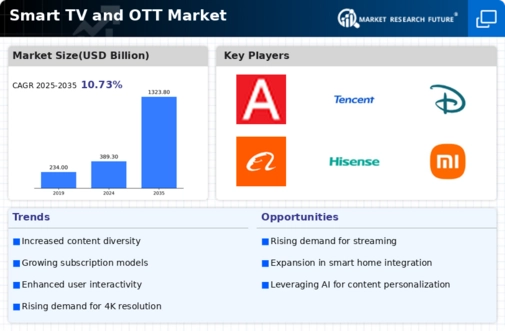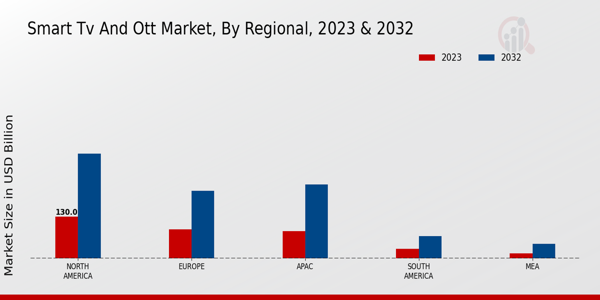Market Growth Projections
The Global Smart TV and OTT Market Industry is poised for substantial growth, with projections indicating a market value of 1323.8 USD Billion by 2035. This growth is underpinned by various factors, including rising consumer demand for streaming content, technological advancements in smart TVs, and the expansion of internet infrastructure. The anticipated compound annual growth rate of 11.77% from 2025 to 2035 reflects the industry's resilience and adaptability in a rapidly changing digital landscape. As more consumers embrace OTT services, the market is likely to evolve, presenting new opportunities for innovation and competition.
Shift in Advertising Strategies
The shift in advertising strategies towards digital platforms is reshaping the Global Smart TV and OTT Market Industry. Advertisers are increasingly recognizing the effectiveness of targeted advertising on OTT platforms, which allows for more personalized marketing approaches. This transition from traditional television advertising to digital formats is driven by the growing viewership of streaming services. As brands allocate more of their advertising budgets to OTT platforms, the revenue generated from these services is expected to rise. This trend indicates a promising future for the industry, as advertising revenues are likely to contribute significantly to the overall market growth.
Expansion of Internet Infrastructure
The expansion of internet infrastructure significantly impacts the Global Smart TV and OTT Market Industry. Improved broadband connectivity and the rollout of 5G networks facilitate faster and more reliable streaming experiences. This infrastructure development is crucial in regions where access to high-speed internet has been limited, thereby broadening the potential consumer base for OTT services. As internet penetration increases globally, more households are likely to invest in smart TVs, further driving market growth. The expected compound annual growth rate of 11.77% from 2025 to 2035 suggests that enhanced internet capabilities will continue to support the industry's expansion.
Technological Advancements in Smart TVs
Technological advancements play a pivotal role in shaping the Global Smart TV and OTT Market Industry. Innovations such as 4K and 8K resolution, HDR capabilities, and enhanced audio technologies are becoming standard features in new smart TV models. These advancements not only improve the viewing experience but also encourage consumers to upgrade their devices. As smart TVs become more integrated with OTT platforms, the seamless user experience enhances viewer engagement. The anticipated growth of the market, projected to reach 1323.8 USD Billion by 2035, underscores the importance of technology in driving consumer adoption and satisfaction.
Increased Investment in Original Content
Increased investment in original content by OTT providers is a key driver of the Global Smart TV and OTT Market Industry. Major streaming platforms are allocating substantial budgets to produce exclusive shows and movies, which attract subscribers and retain existing customers. This trend not only enhances the value proposition of OTT services but also fosters competition among providers. As a result, consumers benefit from a wider array of high-quality content. The ongoing commitment to original programming is likely to sustain the industry's growth trajectory, as evidenced by the market's projected increase to 1323.8 USD Billion by 2035.
Rising Consumer Demand for Streaming Content
The Global Smart TV and OTT Market Industry experiences a surge in consumer demand for streaming content, driven by the increasing availability of diverse programming. As of 2024, the market is valued at 389.3 USD Billion, reflecting a shift in viewing habits towards on-demand services. Consumers are increasingly favoring platforms that offer original content, leading to a proliferation of subscription-based models. This trend is likely to continue as more households adopt smart TVs, which facilitate easy access to OTT services. The growing preference for personalized viewing experiences further fuels this demand, indicating a robust trajectory for the industry.













